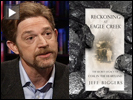
Guests
- Jeff Biggersjournalist covering mining in the Appalachian region. He is the author of The United States of Appalachia.
- Carol RaulstonSenior Vice President for Communications at the National Mining Association.
There have been a number of recent developments around the controversial practice of mountaintop removal coal mining, wherein coal companies remove the tops of mountains with explosives. Last week, the Obama administration indicated it will not immediately cancel Bush-era changes to a rule protecting streams from mountaintop removal mining. The move came as groups opposed to mountaintop removal mining organized nationwide sit-ins demanding EPA intervention to stop the blasting of Coal River Mountain in West Virginia, which Massey Energy began dynamiting last week. We host a debate between journalist and mountaintop removal critic Jeff Biggers and Carol Raulston of the National Mining Association. [includes rush transcript]
Transcript
AMY GOODMAN: We turn now to the controversial practice of mountaintop removal coal mining. That’s the practice by coal companies of removing the tops of mountains with explosives.
Last week, the Obama administration filed court documents indicating it will not immediately cancel Bush-era changes to a rule protecting streams from mountaintop removal mining. Six months ago, Secretary of the Interior Ken Salazar described the Bush administration’s changes to the twenty-five-year-old “stream buffer” rule as, quote, “a major misstep” and “bad public policy.” But on Friday, Glenda Owens, acting director of the Interior’s Office of Surface Mining, said a new rule would only be finished by 2011.
The move came on the same day that groups opposed to mountaintop removal mining organized sit-ins in locations across the country, including the headquarters of the Environmental Protection Agency. They demanded intervention from the EPA to stop the blasting of Coal River Mountain in West Virginia, which Massey Energy began dynamiting last week.
The coal industry, however, says the EPA has already lent a death knell to this form of mining. They point to the EPA’s decision in September to subject seventy-nine mountaintop mining permits in Appalachia to additional review under the Clean Water Act. Last month, the EPA also revoked a permit for the largest mountaintop removal mine in West Virginia, the Spruce mine. The National Mining Association and state coal lobbying groups warn that the EPA’s decisions will negatively impact the livelihoods of people in this region, as well as the country’s energy security.
Well, for more on this issue, we’re joined in Washington, DC by Carol Raulston, the senior vice president for communications at the National Mining Association. And we’re joined here in New York by Jeff Biggers, a journalist covering mining in the Appalachian region. He is the author of The United States of Appalachia.
We welcome you both to Democracy Now! Jeff Biggers, this day has been declared by activists as a day of action. Explain why and your concern with mountaintop removal mining.
JEFF BIGGERS: You know, today is a day of action to save Coal River Mountain, which, Amy and Carol, really is the symbol of our debate today, as Coal River Mountain is the last intact mountain in this historic range. And Massey Energy has begun the blasting process to open up a 6,000-acre mountaintop removal mine that would really destroy the future, a clean energy future, for the region, because this particular range has been designated as a site for one of the largest wind farms in the southeastern region, that would provide 700 jobs, $1.7 million every year in tax revenues, and enough energy for 150 homes forever.
And this is versus a limited supply of coal that Massey is after. It would be a fourteen-year limited supply of coal that would only provide temporary jobs for a handful of people.
For us, this kind of debate really centers now on Coal River Mountain, because we have an alternative, and we really have to look beyond coal to bring the coal fields, I think, into the twenty-first century of economic and sustainable development.
AMY GOODMAN: Carol Raulston, your response?
CAROL RAULSTON: Thank you, Amy and Jeff.
Number one, I think mountaintop mining and surface mining in Appalachia is certainly compatible with other forms of energy. One of the more innovative things that is being done in West Virginia and throughout Central Appalachia is looking at new ways to reclaim mining sites that have been surface-mined. Certainly, wind energy farms are one way to do that. But there’s also land being reclaimed and has been reclaimed for airports, industrial development, housing development, schools, hospitals. So one of the things that is coming out of surface mining in Appalachia is sustained economic future for the region, even after coal mining has ended.
But I think we shouldn’t just dismiss the jobs that are there, either. There are 27,000 people employed in Appalachia at surface mining operations. And they support another 80,000 jobs. The jobs at coal mines pay twice the annual wage in West Virginia, for example. So these are really the economic engines of these communities. There were hearings throughout Appalachia a couple of weeks ago, and 10,000 people showed up at four hearings. These were doctors, teachers, small business owners, along with coal miners, to voice their support for surface mining in Appalachia as a source of economic future for themselves and their families.
AMY GOODMAN: Jeff Biggers, your response?
JEFF BIGGERS: Well, as Carol knows, unfortunately, the facts don’t bear out what she’s saying. Less than three percent of mountaintop removal sites — and this is a fact that has been beared out in all sorts of studies recently — less than three percent of all mountaintop removal sites have actually — have been — returned any kind of economic development. And so, the handful of little golf courses or shopping centers, many of which are now having trouble with subsidence, really is not a reality.
And you actually can’t have both, because — Coal River Mountain is a good example. Here is this incredible range, that if you destroy it, you will reduce completely the wind potential that could have been captured for the wind farm, that just because you have a massive, destructive mountaintop removal operation doesn’t mean that you can come in afterwards and develop it. Often it really creates an incredible stranglehold on the economy.
And then, in terms of jobs, as Carol knows, you know, I’ve been working in the coal fields since 1983, and I come from a coal mining family in southern Illinois. And since 1983, my generation has lost over 60 percent of our jobs. You know, our communities are impoverished. Unemployment is skyrocketing. And that is because you have these highly mechanized operations, like mountaintop removal, that have completely put a stranglehold on any kind of diversified economy and really have plundered our communities and left us in massive poverty.
AMY GOODMAN: Carol Raulston, as representative of the National Mining Association, your response?
CAROL RAULSTON: Certainly mines are much more productive than they were in the past, and that has resulted in needing fewer people to mine the coal. The good news about that is, is new equipment and modern technology has made mining much safer. So we think that’s a beneficial tradeoff.
But I think we have to look at the people who live in these communities. When we go and talk to them — we’ve even done survey research in them — they are strong supporters of surface mining in their areas. They see it as a source of affordable and reliable energy, not only to their communities, but their state and the entire region. And as I said, they see it as a real economic future for them and their families.
Obviously, when you’re in areas that don’t have a lot of population, you may not be able to put in a shopping center. But we are required by law to reclaim all mining sites, and they are — are either reclaimed for some kind of economic purpose or reforested, farmland, recreational properties. And so, there’s a wide diversity of things that are being done throughout Appalachia. We’re working with the American Chestnut Foundation to reintroduce chestnuts to the region. Millions of trees have been planted. That’s allowed us to bring elk back into, for instance, Kentucky. So there’s a lot of really exciting work being done in the coal fields.
AMY GOODMAN: Jeff Biggers?
JEFF BIGGERS: Yeah, and once again, Carol can’t refute the reality that 97 percent of these so-called reclamation sites, like in my own family’s land that was strip-mined, is just a foreign grasslands, and it’s no — no source of economic development whatsoever. And Carol couldn’t retort that. She knows that’s a reality, and she knows the coal industry is not doing its part.
But I think what’s very important is — to point out is how Carol really, in her office in Washington, is out of touch with the realities of the coal fields, the people I deal with daily, who are living in a virtual war zone because of this mountaintop removal operation. They don’t want this. You know, people are dealing with millions of pounds of ammonium nitrate fuel oil explosions every day and the rain of silica dust and heavy metals. People are not able to drink their water. And in some communities, like Prenter, West Virginia, where a young man died of kidney cancer last month, have massive problems with gallbladder disease and infections and whatnot. You have 2,000 miles of streams that have been sullied and jammed with waste. Over 500 mountains and 1.2 million acres of hardwood forest in our carbon sink of Appalachia have been destroyed.
You know, Carol, I think, just doesn’t understand the massive devastation from mountaintop removal. And for why? It produces less than eight percent of our national coal production, and we simply don’t need it.
AMY GOODMAN: Were you encouraged, Carol Raulston, by the Obama administration filing documents last week indicating they won’t immediately cancel the Bush-era changes to a rule protecting streams from mountaintop removal mining? Even though the Interior Secretary now, Ken Salazar, had described the Bush administration’s changes to the twenty-five-year-old stream buffer rule as, quote, “a major misstep” and “bad public policy,” the acting director of the Interior Offices — Office of Surface Mining said the rule change won’t be finished for, well, more than a year. Is that encouraging?
CAROL RAULSTON: Well, I don’t think we look at the timeline or anything as either encouraging or discouraging. What we had said was the administration can’t just summarily do away with this rule, that you had to go through the process so that there could be hearings and people could be heard. That was our main point. But I think what we need to look at again is, there’s a tremendous amount of concern throughout Appalachia right now that permits are not being issued and jobs are in jeopardy, not only coal mining jobs, but jobs that are there at equipment manufacturers that service the industry, at restaurants and schools and all kinds of businesses and services throughout Appalachia that depend upon coal mining.
AMY GOODMAN: Have you been discouraged, Carol Raulston, by the level of activism and protest, people like James Hansen, one of the leading climatologists, head of the Goddard Institute for Space Studies at NASA, protesting mountaintop removal, getting arrested, involved in these protests?
CAROL RAULSTON: Well, Dr. Hansen, I think, is certainly entitled to his views, just as Jeff is, and — but these are actually small groups of protesters. There were thirteen people at EPA last week, where we had 10,000 people at hearings at rather remote locations throughout Appalachia earlier —- last month. The numbers are really very one-sided, when you actually get into these local communities. They’re very concerned that it is people from the outside that are trying to end their livelihood and to end the future of their families.
AMY GOODMAN: Jeff Biggers, small groups of people? And we’re going to end here.
JEFF BIGGERS: Right.
AMY GOODMAN: Outsiders coming in?
JEFF BIGGERS: It’s not outsiders. It’s actually Coal River. It’s people in the coal fields now who are saying they can’t take it anymore. They’re living in a state of emergency. The only people who are supporting mountaintop removal are those who are on its bankroll. The only people who are supporting the coal industry’s outlaw operations are people like Carol and people who are on the bankroll of the coal industry. And Carol’s sort of exaggerations -—
AMY GOODMAN: But she said 10,000 people coming in.
JEFF BIGGERS: Yeah, and actually it’s not true. It wasn’t 10,000. There was a few thousand in West Virginia and a few thousand in Kentucky. And there were, as well, thousands of people, as well, who were there.
The problem was, Carol’s exaggeration really is symbolic of how the coal industry and the National Mining Association is inflaming the coal field tensions by saying, “You’re going to lose your job. Everyone’s going to be thrown out.” And in truth, Massey Energy, just last week, Don Blankenship told a stock analyst that they’re not being affected the permits, in this year or next year, and, if necessary, they can go to deep underground mining, that there is an option other than surface mining.
And I think that’s what Carol is not being forthcoming on, is that the region wants to move on. They want green jobs. They want to save Coal River Mountain and have clean energy forever. And I think Carol, like the rest of the nation — and we’re talking hundreds of thousands of people, every poll in West Virginia shows that the majority of the people want to stop mountaintop removal. They really need to go to ilovemountains.org to really look at the future of what’s going to be happening.
AMY GOODMAN: We’re going to leave it there. I want to thank you, Jeff Biggers, journalist covering the Appalachian region — his book is The United States of Appalachia — and Carol Raulston, senior vice president for communications at the National Mining Association, joining us from Washington. When we come back, we continue on this issue of the environment. We will, though, go to Brazil. Stay with us.












Media Options